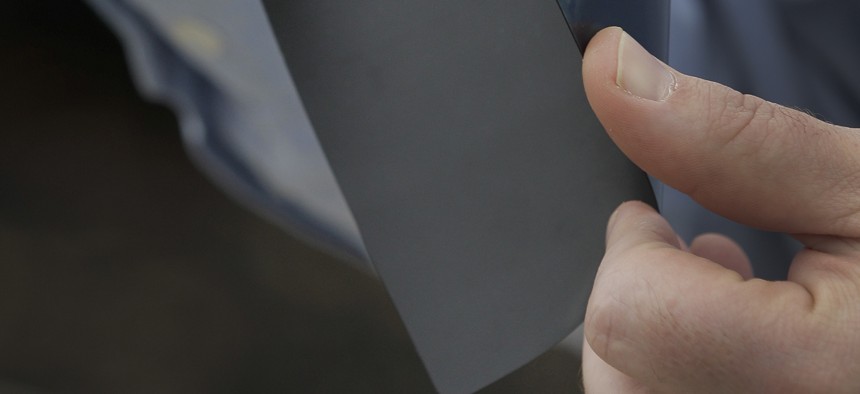
In this Nov. 16, 2011 photo, Kent Displays/Improv Electronics communications director Kevin Oswald shows off the company's flexible plastic LCD screen at the Kent, Ohio company. AP / Amy Sancetta
US Special Operations Forces Making Paper That Talks
Future psychological operations will airdrop the sheets to persuade targets to buck up or defect.
Special operators have been looking for a way to get a short audio message to target audiences in enemy-controlled areas — say, civilians in need of reassurance or enemy soldiers who might surrender or defect. Now they think they have one: a piece of paper, about the thickness of four ordinary sheets, infused with microcircuits that can store and replay a 30-second message.
U.S. Special Operations Forces Command, or USSOCOM, has developed a prototype; now they’re looking for companies to improve it enough for combat evaluations as soon as year’s end.
In May, SOCOM representatives were reaching out to industry and academic partners at the SOFIC conference in Tampa, Florida. A SOCOM video display described a need for a “printable electronics incorporating ‘flexible micro-circuitry’, [a] flexible speaker, and super thin photovoltaic batteries.”
Ryan Brown, an acquisition official with SOCOM, said the prototype has a writable area of about 4 by 6 inches. Now he’s looking to make it better and cheaper. “One of the downsides of making something new… the first-time articles and prototypes are expensive,” Brown said.
The display at SOFIC said that the paper should be printable “in the field [to be] deployed or scattered across designated areas to broadcast information as well as provide feedback to assist in MISO planning and analysis.”
MISO is Military Information Support Operations, the special ops group that focuses on psychological operations. While less well-known than the troops that kick down terrorists’ doors, MISO (formerly PSYOPS) plays a growing role in high-profile military operations.
For instance, psychological operations helped decimate Joseph Kony's Lord’s Resistance Army, or LRA, SOCOM officials said last year. Operators said the nearly six-year operation was aided by delivering recorded messages to LRA soldiers, persuading them to defect. But it’s hard to reach enemy soldiers deep in the jungle, especially when they are is surrounded by other combatants. Furthermore written messages don’t always work if the target is illiterate, as many of Kony’s child soldiers were. The SOF operators resorted to dropping devices to relay the messages into areas that they knew LRA members would be.
Over time, the operation had the desired effect, culminating in the defection of Michael Omono, Kony’s radio telephone operator and a key intelligence source. Army Col. Bethany C. Aragon described the operation from the perspective of Omono.
“You are working for a leader who is clearly unhinged and not inspired by the original motivations that people join the Lord’s Resistance Army for. [Omono] is susceptible. Then, as he’s walking through the jungle, he hears [a recording of] his mother’s voice and her message begging him to come home. He sees leaflets with his daughter’s picture begging him to come home, from his uncle that raised him and was a father to him.”
It’s exactly the sort of operation that could be aided by electronic talking paper.
Various printable electronic concepts have been around for close to a decade. But the advent of new techniques to mass-produce graphene — a carbon-based nanomaterial that’s clear, highly bendable, five times as strong as steel and an excellent conductor of electricity — has made it much easier to shrink electronic circuits and embed them into fabric or other bendable materials. (SOCOM officials declined to say whether their prototype uses graphene or other materials.)
Brown said that future versions of the material may host a biometric identifier, perhaps allowing only the intended recipient of the message to access it, but that wasn’t part of the prototype or the present industry outreach.
The same display also said that the military was working on a “leaflet that allows for listen back.”




